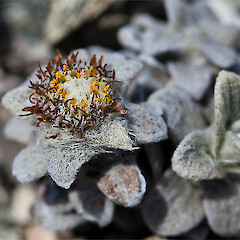Haastia sinclairii var. sinclairii
Common name
Sinclair’s Haastia
Synonyms
Haastia sinclairii Hook.f.
Family
Asteraceae
Flora category
Vascular – Native
Endemic taxon
Yes
Endemic genus
Yes
Endemic family
No
Structural class
Herbs - Dicotyledonous composites
Chromosome number
2n = 60
Current conservation status
The conservation status of all known New Zealand vascular plant taxa at the rank of species and below were reassessed in 2017 using the New Zealand Threat Classification System (NZTCS) – more information about this can be found on the NZTCS website. This report includes a statistical summary and brief notes on changes since 2012 and replaces all previous NZTCS lists for vascular plants.
Please note, threat classifications are often suggested by authors when publications fall between NZTCS assessment periods – an interim threat classification status has not been assessed by the NZTCS panel.
- Conservation status of New Zealand indigenous vascular plants, 2017 . 2018. Peter J. de Lange, Jeremy R. Rolfe, John W. Barkla, Shannel P. Courtney, Paul D. Champion, Leon R. Perrie, Sarah M. Beadel, Kerry A. Ford, Ilse Breitwieser, Ines Schönberger, Rowan Hindmarsh-Walls, Peter B. Heenan and Kate Ladley. Department of Conservation. Source: NZTCS and licensed by DOC for reuse under the Creative Commons Attribution 4.0 International licence.
2017 | Not Threatened
Previous conservation statuses
2012 | Not Threatened
2009 | Not Threatened
2004 | Not Threatened
Distribution
Endemic. South Island: Marlborough to Otago (mainly east of divide)
Habitat
Subalpine to alpine screes
Detailed description
Plant sparingly to much branched, decumbent to suberect. Branchlets up to c. 300 mm long, 4-6 mm. diameter. Leaves more or less patent, up to 35 × 15 mm, oblong-obovate, subacute to rounded at apex, densely clad in whitish subappressed tomentum, except on upper surface of appressed base, upper part slightly thickened, somewhat rugose; veins 5-10, anastomosing above. Capitula c.30 mm diameter; receptacle 5-6 mm diameter. Involucral bracts narrow-oblanceolate, subacuminate, pilose on lower surface, c.10 mm long. Achenes c. 2 mm long, narrow-linear. Pappus up to 10 mm long.
Similar taxa
Distinguished from Haastia pulvinaris by the less compact, openly branched, distinctly leafy growth habit. Haastia sinclairii differs from H. recurva by the spreading and not recurved, rather than strongly recurved leaves, and appressed to subappressed rather than floccose leaf tomentum. Haastia sinclairii var. sinclairii is easily distinguished from var. fulvida by the greyish-white to white rather than fulvous-yellow to buff coloured tomentum.
Flowering
November - March
Flower colours
Orange, Yellow
Fruiting
December - April
Life cycle
Pappate cypselae are dispersed by wind (Thorsen et al., 2009).
Propagation technique
Difficult. Should not be removed from the wild
Etymology
haastia: After Haast
sinclairii: After Sinclair (c. 1796–1861). Colonial Secretary and naturalist.
Where To Buy
Not commercially available
Attribution
Description adapted from Allan (1961)
References and further reading
Allan, H.H. 1961: Flora of New Zealand. Vol. I, Government Printer, Wellington.
Thorsen, M. J.; Dickinson, K. J. M.; Seddon, P. J. 2009. Seed dispersal systems in the New Zealand flora. Perspectives in Plant Ecology, Evolution and Systematics 11: 285-309












